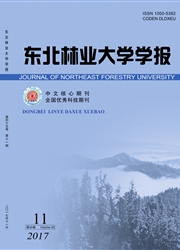

 中文摘要:
中文摘要:
以小型填埋反应器模拟实验(恒温(36±2)℃,运行120d)为基础,采用pH值调节、营养元素添加(Fe^3+和S^2-)以及微生物接种3种处理方式,研究了生活垃圾填埋降解过程中纤维素酶、淀粉酶变化和产气情况。结果表明:3种处理方式下淀粉酶活力均显著高于纤维素酶活力(P〈0.01),纤维素水解酶活力在偏酸性(pH4.5~6.0)条件下较高,而淀粉酶在酸性较强(如pH4.5)的条件下活性较低。添加Fe^3+条件下纤维素酶活性增强,而淀粉酶活性减弱;Fe^3+的加入可显著促进甲烷气体的产生和及其体积分数的提高,产气时间延长,S^2-对两种水解酶活力的影响与Fe^3+的趋势相同,但幅度较小。接种微生物是促进城市生活垃圾快速降解产气的有效方式,水解酶活力和产气量及甲烷体积分数均显著增加,仅接种微生物的反应器气体甲烷体积分数达到55%以上,而微生物接种和Fe^3+加入相结合的方式反应器气体甲烷体积分数达到62%以上。
 英文摘要:
英文摘要:
A small-scale investigation was conducted to evaluate the characteristics of hydrolase activities, such as cellulose activity and amylase activity, and the biogas generation of municipal solid waste (MSW) such as vegetables and kitchen food during the degradation. The experiment lasting 120 days was carried out at (36 ±2)℃, and three treatments including pH adjustment, nutrient addition( Fe^3+ and S^2- )and microorganism inoculation were designed. Results showed that amylase activity was significantly higher than that of cellulose (p 〈0.01 ) under the treatments mentioned above, and cellulose activity performed well at pH from 4.5 to 6. 0, while amylase acted inefficieiently at a pH as low as 4.5. Fe^3+ addition stimulated the cellulose activity but inhibited the activity of amylase, and biogas production and CH4 eoneemration were promoted and duration of time in biogas-produeing was prolonged as well. Stimulation of S^2- addition to the two kinds of hydrolases was similar to Fe^3+ supplementation. Inoculation is an effective method in accelerating the degradation and biogasification of municipal solid waste. The hydrolase activities and CH4 concentration obviously increased when inoculation was performed, and CH4 concentration reached 55% in inoculated bioreactors and up to 62% when Fe^3+ and microorganism were added simultaneously.
 同期刊论文项目
同期刊论文项目
 同项目期刊论文
同项目期刊论文
 期刊信息
期刊信息
